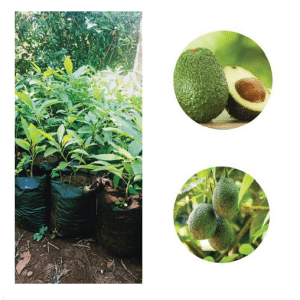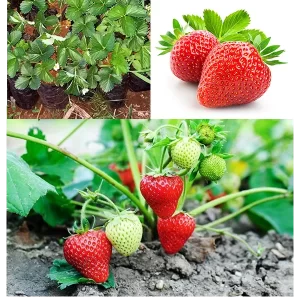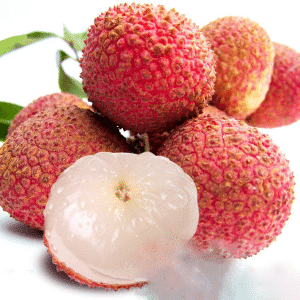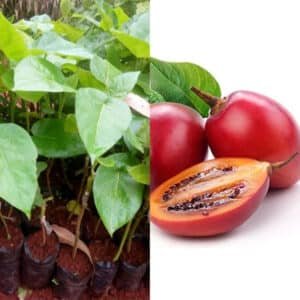Plum Seedlings
Prunus domestica, commonly known as Plum is a juicy and delicious fruit that belong to the genus Prunus of the Rosaceae family which also includes peaches, apricots, and nectarines. The plant is native to Southwest Asia. It is an ancient domesticated species, known only in cultivation, that is now cultivated in temperate areas worldwide for its fruit.
The species, which was first recorded in cultivation by the Syrians and then the Romans, and spread to western Europe during the Crusades, is likely derived from one or a combination of several Eurasian progenitors: cherry plum (P. salicifera); sloe (P. spinosa); and damson plum (P. insititia). It small to medium size, deciduous tree that grow for its fruit. Plums are one of the most popular of stone fruits.
Plant Description
Plum is a small, branched, deciduous tree that grows about 9 to 15 m (29 to 50 ft.) tall. It prefers a sunny well-drained, fertile soil. Clay loams are tolerated as long as drainage is good. Sandy soils are also suitable mainly if they are attached on nematode resistant rootstock.
The plant has reddish-brown, glabrous branches, unarmed or armed with few spines. Branchlets are reddish-brown to greyish-green, and are pubescent. The plant has reddish to brown bark. Plums are grown commercially in orchards, but modern rootstocks, together with self-fertile strains, training and pruning methods, allow single plums to be grown in relatively small spaces like home gardens. Its early flowering and fruiting means that they require a sheltered spot away from frosts and cold winds for the better development of the plant. For the Essential Guide To Plum Tree Gardening
Leaves
Leaves are alternate, deep green, elliptic to obovate, 4–10 × 2.5–5 cm, pubescent below, glabrous above, margins serrulate, apex acute to obtuse, base cuneate with a pair of nectaries, and with 5–7 pairs of lateral veins.
Flower
The flower is solitary or in fascicles of 3 at the tip of branchlets, pedicellate (10–12 mm), 10–15 mm across. Hypanthium is pubescent; sepals 5, ovate with acute apex, imbricate; petals 5, white or greenish-white, obovate, apex rounded to obtuse, imbricate, on rim of hypanthium; stamens 20–30, in 2 whorls; filaments unequal; carpel 1; ovary superior, 1-loculated, glabrous or sometimes villous; style terminal, elongated. Flowering normally takes place in April.
Fruit
Globose to oblong, rarely sub-globose fruit varies in size but can be measured about 5-6 cm in diameter with a hard, stony, flattened pit. The fruit is green when young turning to red, purple, purple-black, yellow, or golden yellow, often with a glaucous (white waxy) bloom on the surface. It is really an epicuticular wax covering and is also referred to as “wax bloom”. Skin is smooth yellow or dark red to purple or black. Inner flesh varies widely from creamy yellow, crimson, light blue, or light-green in color depending upon the cultivar type. The fruit has a pleasant aroma and a sweet and tart taste. Some varieties are usually sweet (dessert plum), though some varieties are sour and require cooking with sugar to make them palatable. Like all Prunus fruits, it contains a single large seed, usually called a stone, which is discarded when eating. The average weight of the fruit is about 50-70 g.
History of Plums
Prunus domestica is supposed to have originated in the area of the Caucasus and Asia Minor. The first findings of primitive cultivars were reported to occur in Central Europe about 500 BC, probably known already by the Celtic and Teutonic tribes. Subsequently, the fruit was dispersed to countries in central Europe by the Romans. It is probable that high-quality cultivars originated from southeast Europe after the Middle Ages, and were distributed throughout Europe by the seventeenth century. Plum is now cultivated globally in temperate to warm-temperate regions, mostly in Central, S, and SE Europe, further on in N Africa, W Asia, India and North America, Australia, New Zealand, South Africa, and in South America.

Health Benefits of Plums
Plum Fruits for the human body is very amazing, mainly for preventing cancer. You call it plum when it is fresh, and you call it prune when it is dried, but both of them are full of nutrients. So no matter which type you eat, you can still reap the benefits. They are packed with an immense range of phenols and flavonoids, which offer an impressive range of health benefits. Listed below are a few of the health benefits of plum fruit
1. Cardiovascular Health
Regular consumption of plums is quite beneficial for maintaining cardiovascular health. Research has proven that the regular intake of dried plums helps in promoting the fluidity of blood in the arteries. This protective effect aids in the prevention of various cardiac complaints, including the development of atherosclerosis and the reduction in the chances of heart attacks and strokes. (1)
2. Prevent Cancer
Several researches have proven that plum extracts have been proven beneficial in the treatment of cancer. Research has shown that the component epicatechin, present in plums, helps in preventing the growth and proliferation of malignant cancer cells and encourages apoptosis in human hepatocellular carcinoma or liver cancer. They are rich in antioxidants and phytonutrients, including chlorogenic acid and neo-chlorogenic acid which have a restorative effect on breast cancer cells, without harming the normal healthy cells of the body.
3. Prevent Osteoporosis
Regular Consumption of dried plums exerts anabolic and anti-resorptive actions, which aid in maintaining healthy bones. Plums consist of Flavonoids such as caffeic acid and rutin which helps in preventing the deterioration of bone tissues and prevent diseases such as osteoporosis in postmenopausal women. Polyphenols, along with the potassium content present in dried plums, encourage the formation of bones, enhance bone density, and prevent bone loss caused by ovarian hormone deficiency. Research has proven that regular consumption of dried plums helps in the restoration of bone density that has already been lost due to aging.
4. Boost Immunity
Plums consist of Vitamin C which is proven beneficial in strengthening the immune defense of the body. It helps to promote the body’s resistance against various infections and inflammations. Research has shown that oriental plums have immune-stimulatory constituents that encourage the production of nitric oxide in the body, obstruct the metastasis of tumor cells, and are valuable in preventing various diseases.
5. Skin Care
Plum consists of a huge amount of vitamin C, along with other antioxidants, which help to maintain healthy, radiant, and youthful skin. Regular consumption of plums helps in reducing dark spots and wrinkles due to the presence of anti-aging nutrients. Plum extracts are used in various skin care products such as face wash and packs.
6. Macular Degeneration
Vitamin A and beta-carotene contained in plums are beneficial in maintaining healthy eyesight and preventing age-related macular degeneration. Carotenoids lutein and zeaxanthin present in them reside in the macular tissues of the retina and provide protection against the damage caused by UV radiation.
7. Fights Signs of Aging
Vitamin E and beta-carotene, an antioxidant in plums, protect the fatty acids and the cell membranes from the attack of free radicals, which allows the body to fight the signs of aging skin such as loss of elasticity and wrinkles. Plum contains a high amount of antioxidants and high anti-inflammatory properties, which increase circulation and cell metabolism, reducing inflammation. This, in turn, encourages the elasticity of the skin and keeps acne and wrinkles at bay.
8. Control Diabetes
Plums use anti-hyperglycemic effects and help in combating diabetes. Research has shown that the consumption of plum extracts aids in the reduction of blood glucose and levels of triglyceride in the body. Flavonoids present in plums exert protective effects against insulin resistance and help to enhance insulin sensitivity in the body.
9. Regulate Cholesterol Levels
Dried plums or prunes are quite helpful in preventing hypercholesterolemia and hyperlipidemia. Research has proven the effectiveness of prunes over grape juice in maintaining healthy levels of plasma and liver cholesterol. The fiber content present in it also adds to the protective effect of the heart by reducing LDL cholesterol and helping to elevate the levels of HDL cholesterol (good cholesterol).
10. Blood Clotting
Plums and prunes consist of a good amount of vitamin K, which helps in the normal clotting of the blood and promotes bone health. Deficiency of vitamin K in the body can result in excessive blood loss and other health concerns such as weak bones.
11. Aid in Digestion
Plums are a good source of dietary fiber, along with the components sorbitol and isatin, which help in regulating the digestive system. Research has proven that dried plums or prunes are more effective in treating digestive disorders like constipation as compared to other remedies such as psyllium husk. Sorbitol and isatin have a laxative effect and encourage the secretion of fluids in the bowels and promote the efficient flushing of waste through the colon.
12. Nervous System
Plums consist of vitamin B-6, which helps in the transmission of nerve signals and aids in the smooth functioning of the nervous system. They also help in the normal growth of the brain and assist in the formation of mood-influencing hormones. Tryptophan, an amino acid present in them, helps in the production of the neurotransmitter serotonin, which plays an important role in sleep, appetite, and concentration.
13. Aids in Weight Loss
Plums also remove toxins and prevent constipation, leading to weight loss naturally. Plum is rich in fiber and antioxidants, which aid proper digestion and good metabolism. It contains citric acid, which prevents tiredness and cramps. It also improves liver and gastrointestinal function. Thus, eating plums or drinking plum juice regularly will help you shed those extra pounds easily.
14. Useful in Pregnancy
Plum products are quite beneficial during pregnancy, due to the abundance of numerous vitamins and minerals. These beneficial components are vital for eye-sight, the development of bones and tissues, and cellular health for the mother and the growing baby. The fiber content aids in preventing constipation and improves digestion. The inclusion of plums as a part of a balanced diet helps in fighting various infections and maintains overall health. However, one should be careful regarding the choice of commercially available plum juices as they might contain high amounts of sugar.
15. May Relieve Constipation
Prunes and prune juice are well known for their ability to relieve constipation. This is partly due to the high amount of fiber in prunes. One prune provides 1 gram of fiber.
The fiber in prunes is mostly insoluble, which means it does not blend with water. It plays a role in preventing constipation by adding bulk to your stool and may speed up the rate at that waste moves through your digestive tract. Additionally, prunes and prune juice contain sorbitol, which is a sugar alcohol with natural laxative effects.







There are no reviews yet.